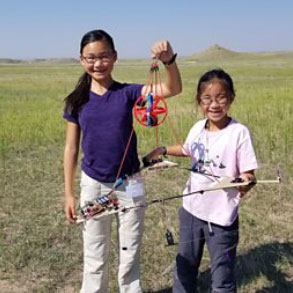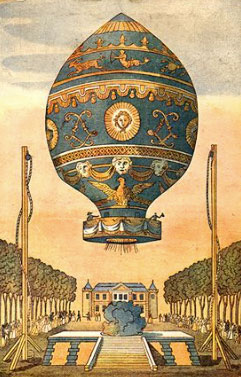Aerospace Micro-Lesson #6
In This Section
Up, up, and Away in my Beautiful Balloon

In September 2015, two Seattle girls launched a balloon that reached the edge of space. The girls, ages 8 and 10 years old, built the craft and equipped it with 2 video cameras and a GPS tracking device. With help from their parents, the girls filled the balloon with helium and launched it. It was able to reach a distance of 78,000 feet above the earth. Videos from that and two follow-up flights are available on their website at Loki Lego Launcher. Not every student may have the chance to catch the attention of NASA and collaborate with the Ames Research Center, but they may all enjoy learning about the different types of balloons.
Next Generation Science Standards (NGSS):
- Discipline: Earth materials and systems
- Crosscutting Concept: Structure and function
- Science & Engineering Practice: Constructing Explanations
GRADES K-2
Grades K-2: K-PS2-1. Plan and conduct an investigation to compare the effects of different strengths or different directions of pushes and pulls on the motion of an object.
After watching the video of Kimberly and Rebecca’s balloon launch, you may wish to read aloud a book about a balloon trip. Eleanor Coerr’s, The Big Balloon Race, is based on the true story of a hydrogen balloon race and a real ballooning family in the late 1800s.
GRADES 3-5

Grades 3-5: 3-PS2-1. Plan and conduct an investigation to provide evidence of the effects of balanced and unbalanced forces on the motion of an object.
After watching the video of Kimberly and Rebecca’s balloon launch, teachers may wish to read aloud a book about the first balloon ever launched with passengers on board. Marjorie Priceman’s, Hot Air: The (Mostly) True Story of the First Hot-Air Balloon Ride, is based on the true story of a hot-air balloon launched in 1783 with a duck, a sheep, and a rooster on board as the first passengers. “Put a Balloon on It” features a scale model of the Montgolfier brothers’ balloon.
* (The first free ascent of a hot-air balloon with human passengers, on Nov. 21, 1783. — Jean-François Pilâtre de Rozier and the Marquis d´Arlandes (Image credit: 2001 National Air and Space Museum, Smithsonian Institution (SI Neg. No. 93-2342)
GRADES 6-8
Grades 6-8: MS-PS2-2. Plan an investigation to provide evidence that the change in an object’s motion depends on the sum of the forces on the object and the mass of the object.
After watching the video of Kimberly and Rebecca’s balloon launch, teachers may choose to discuss the history of ballooning with the class. The article, “A Short History of Ballooning,” is a good introduction. Students may also enjoy the PBS video, “Riding In a Hot Air Balloon Shaped Like a Pig… For SCIENCE.”
For a more hands-on approach, follow the directions for a Hot Air Balloon (from NASA’s Glenn Research Center) on how to stage a hot-air demonstration using only a dry cleaning bag, a hair dryer, and some paper clips.
GRADES 9-12
Grades 9-12: HS-PS2-1. Analyze data to support the claim that Newton’s second law of motion describes the mathematical relationship among the net force on a macroscopic object, its mass, and its acceleration
The GeekWire article says that the actual flight path of Kimberly and Rebecca’s balloon is considerably longer than the projected flight path and traces the cause back to an error in the weight of the payload. The payload was heavier than the girls had calculated that it would be; intuitively one would think that a heavier payload would cause a shorter flight path, but this was not the case. It may be helpful to work through the chain of reasoning that leads from a heavier payload to a longer flight path. Usually when one considers weight and path length, one is heaving the load with force main; in the case of the balloon, though, the balloon is lifting the payload because of its buoyancy. A heavier payload means that there is less net buoyancy and therefore a smaller net upward force on the balloon as a whole. The smaller net force is more easily counteracted by aerodynamic drag, causing the balloon to rise more slowly. The slower rise of the balloon gives it more time to be blown along its horizontal path by the wind, which leads to a longer flight path. The balloon burst at the same altitude as it was predicted to.
The shape of the actual flight path is almost the same as the shape of the predicted flight path. This is because the direction of the wind depends most strongly on the altitude. The balloon spent proportionally about the same amount of time at each altitude as it was predicted to; and thus the relative proportions of the different parts of the flight path are about the same.
This is not a unique accomplishment; many other young people (with help from adults) have also sent cameras and small payloads up to the upper atmosphere:
- Students Send Balloons to the Stratosphere
- That's out of this world! Homemade helium space balloon captures breathtaking footage above the Scottish highlands
- Girl Launches Hello Kitty Doll Into Stratosphere (Video)
- Father and son launch video camera into outer space
Sixty Years Ago in the Space Race:
1 Jul. 1960 On this date the Army Ballistic Missile Agency of the Redstone Arsenal, Huntsville, Alabama, formally became a part of NASA and was renamed the George C. Marshall Space Flight Center. This organization included the German "rocket team" led by Wernher von Braun that came to the United States at the conclusion of World War II. This group had been instrumental in building the V-2 rocket, the world's first operational long-range ballistic missile.
